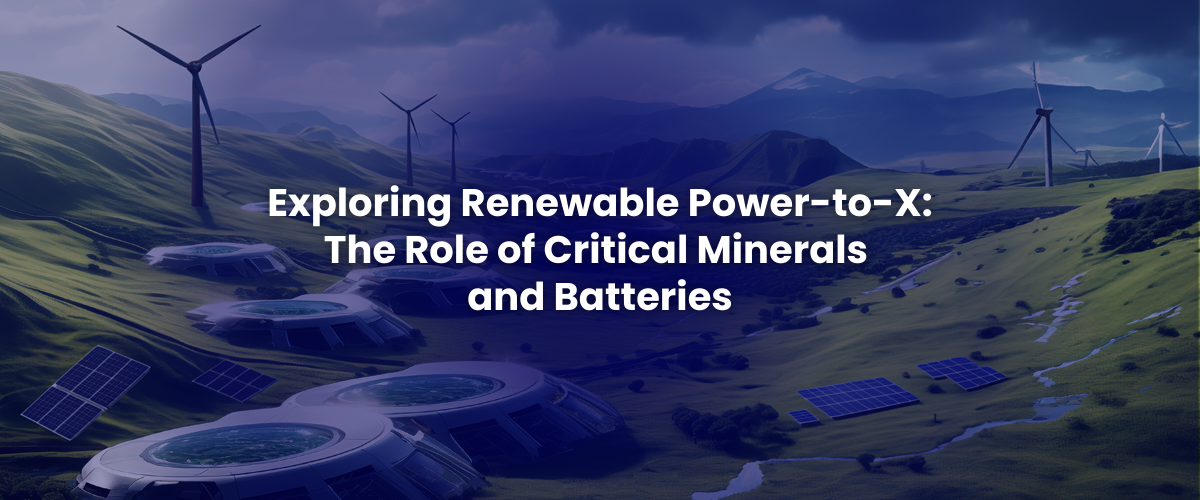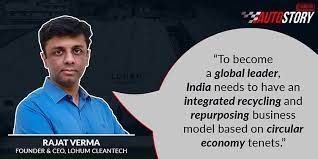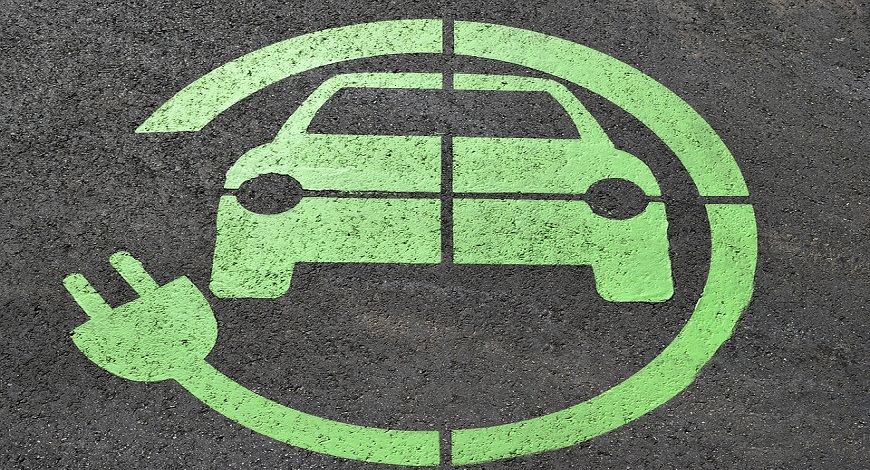
Table of Contents
Renewable Power-to-X (P2X) is emerging as a viable platform for storing excess renewables for end-use and providing a low capital-intensive decarbonization pathway to produce green fuels & chemicals. P2X applications increasingly use technologies that require critical minerals and may also integrate Lithium ion batteries and other forms of energy storage in conjunction. In P2X, “excess” and underutilized renewable power resources are used to power other clean technologies that are capable of converting widely abundant resources such as air and water to produce a variety of fuels.
These energy carriers and chemical products provide significant versatility in renewable energy storage that helps solve its intermittency, transportation, and subsequent conversion. These ‘green fuels’ serve various roles from end-points to intermediaries and decarbonize energy infrastructure.
P2X also offers notable advantages over other emerging energy storage systems, such as battery and pumped hydro which are scale-, time-, and site-specific, and cannot be used to transport energy over large geographical distances. This edition of the Lohum Green Gazette will overview the integration with Lithium ion Batteries and other forms of Energy Storage, and the Critical Minerals involved in P2X technologies.
What is Renewable Power-to-X (PtX or P2X)?
Power-to-X (PtX) refers to technologies that convert electricity into heat, hydrogen, or synthetic fuels, which can then be used in various sectors such as transportation, industry, and heating. Critical materials play a significant role in the development and efficiency of these technologies.
These materials are essential for the efficiency and scalability of PtX technologies. However, their supply chains can be vulnerable to disruptions, making it important to develop sustainable critical mineral sourcing and recycling strategies.
How ‘green’ are the various ‘X’ in P2X?
Power-to-X (P2X) involves converting renewable electricity into various forms of energy or chemicals. Here’s a look at the different fuels, their byproducts, emissions, and applications:
Hydrogen (Power-to-Hydrogen) Electrolyzers
Proton Exchange Membrane (PEM) Electrolyzers: Used for producing high-purity hydrogen. Platinum and iridium catalysts are used in the membrane to facilitate the electrolysis process.
Alkaline Electrolyzers: Nickel is used for electrodes and catalysts in Nickel Based Water Electrolyzers in combination with potassium hydroxide (KOH) or sodium hydroxide (NaOH) alkaline solutions, making them cost-effective for large-scale hydrogen production.
Solid Oxide Electrolyzers: Zirconium-based electrolytes are used for high-temperature electrolysis, which is efficient for industrial applications.
Overview:
- Production: Produced via electrolysis of water using renewable energy.
- Byproducts: Oxygen.
- Emissions: When used in fuel cells, the only emission is water vapor, making it very clean.
Applications:
- Fuel Cells: Used in vehicles, providing electricity with water as the only byproduct.
- Combustion: Can be burned in engines or turbines, emitting water vapor and small amounts of nitrogen oxides (NOx) if not controlled.
Methane (Power-to-Methane)
Overview:
- Production: Produced by methanation of H2 and CO2
- Byproducts: Water.
- Emissions: When burned, it emits CO2 and water. If the CO2 used in production is captured from the atmosphere, it can be made carbon-neutral.
Applications:
- Combustion: Used in heating, power generation, and as a vehicle fuel.
- Conversion to Electricity: Can be used in gas turbines or engines.
Methanol (Power-to-Methanol)
Overview:
- Production: Produced from H2 and CO2
- Byproducts: Water.
- Emissions: When burned, it emits CO2 and water. Like methane, it can be carbon-neutral if the CO2 is sourced sustainably.
Applications:
- Combustion: Used as a fuel in internal combustion engines.
- Conversion to Electricity: Used to produce other chemicals and materials.
Ammonia (Power-to-Ammonia)
Overview:
- Production: Produced from hydrogen and nitrogen through the Haber-Bosch process.
- Byproducts: None significant.
- Emissions: When used as a fuel, it emits nitrogen and water. Combustion can produce NOx, which needs to be managed.
Applications:
- Fertilizer: Widely used in agriculture.
- Fuel: Can be used in combustion engines and fuel cells.
Synthetic Fuels (Power-to-Liquid):
In Fischer-Tropsch Synthesis, cobalt, and iron catalysts are used to convert hydrogen and CO2 into synthetic hydrocarbons like diesel and gasoline. In Methanol Synthesis, copper and zinc catalysts are used to produce methanol from hydrogen and CO2. The Methanol can then be utilized either as a fuel or chemical feedstock.
Overview:
- Production: Produced from hydrogen and CO2, creating synthetic hydrocarbons like diesel and gasoline.
- Byproducts: Water.
- Emissions: When burned, they emit CO2 and water. While they also release SOx and NOx into the environment, the emissions are less in amount compared to other organic fuels.
Applications:
- Combustion: Used in existing internal combustion engines and jet engines.
- Chemical Feedstock: Used to produce various chemicals.
By using renewable energy for production and capturing CO2 from sustainable sources, these fuels can significantly reduce greenhouse gas emissions compared to fossil fuels.
The Critical Minerals in P2X Technologies
Critical Minerals in Electrolyzers
Electrolyzers are essential for splitting water into hydrogen and oxygen. The critical minerals used in electrolyzers include:
- Platinum and Iridium: Used as catalysts in Proton Exchange Membrane (PEM) electrolyzers. These materials help speed up the electrolysis reaction.
- Nickel: Used in Alkaline electrolyzers as a catalyst and for electrodes.
- Zirconium: Used in Solid Oxide Electrolyzers (SOE) for the electrolyte.
As Catalysts for Fuel Synthesis
Catalysts are crucial for converting hydrogen and CO2 into various fuels.
- Cobalt and Iron: Used in Fischer-Tropsch synthesis to produce synthetic hydrocarbons.
- Copper and Zinc: Used in methanol synthesis from hydrogen and CO2.
- Ruthenium: Used in ammonia synthesis as a catalyst.
How Lithium ion batteries are enhancing Renewable P2X
Stabilizing Energy Supply:
Lithium ion batteries can store surplus renewable energy and provide a stable supply for P2X processes, which is crucial for continuous production.
Peak Shaving and Load Balancing:
Lithium ion batteries can help manage peak loads and balance the grid, ensuring that renewable energy is efficiently used.
Integration with Renewable Sources:
Lithium ion batteries can be integrated with solar and wind power systems to store energy when production is high and supply it when needed.
Supporting Decentralized Systems:
They enable decentralized energy systems, reducing the need for large-scale infrastructure and making P2X more accessible.
Sustainable Circularity:
Lithium ion batteries become fully circular when recycled at high yields and purity levels, and recycling them can supply various critical minerals needed across the energy transition. Additionally, the same technologies used for recycling battery materials, can be further expanded to recycle PGM or REE elements, an endeavor well underway at Lohum.
The utilization of lithium ion batteries extends beyond electric vehicles and transportation, offering a spectrum of benefits to reduce carbon footprint across various industries. Advancing the energy transition from grid stabilization to P2X and beyond, Lohum is expanding the scope and scale of circularity in critical minerals and Lithium ion batteries.
Related blogs
This entrepreneur wants India to make its own lithium-ion cells for electric vehicle batteries

Forbes India
Rajat Verma already recovers raw materials from used cells at his venture, LOHUM Cleantech. He wants to close the loop by making cells in India as well.
India needs integrated recycling and repurposing battery business model: Rajat Verma of LOHUM Cleantech

YOURSTORY
In an interaction with AutoStory, Rajat Verma, Founder and CEO of LOHUM Cleantech, speaks about building his company, and about battery manufacturing and repurposing as an industry.
Sourcing Raw Materials Is A Big Challenge In Li-ion Battery Space: Founder Lohum

Business World Disrupt
Recognized as ‘The Most Innovative Company of the year 2022’ by The Confederation of Indian Industry (CII), LOHUM is a producer of sustainable Li-ion battery raw materials